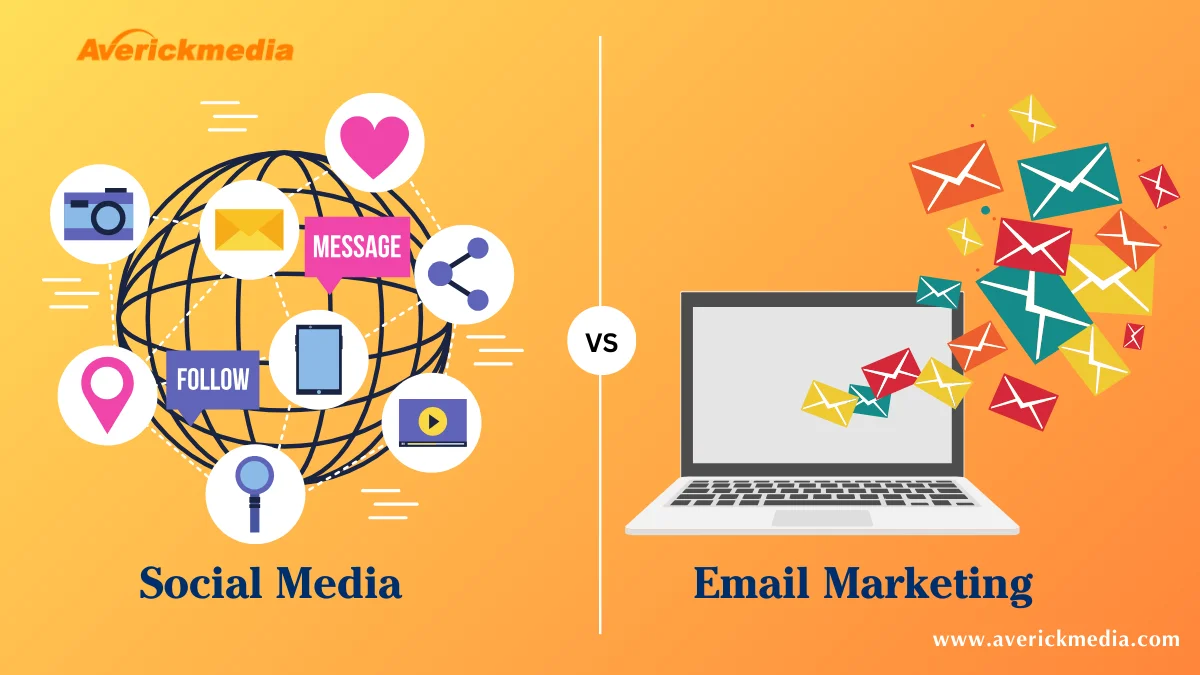Social Media Or Email Marketing - Market Insights

It’s 2024, and people are still confused between social media marketing and email marketing. And rightly so; email used to be the go-to medium for marketing communication and is still ruling the B2B landscape. However, With the increasing popularity of social media marketing, business owners often question the role of email marketing in today's world.
We know that you want a definite answer- that’s why you’re reading this blog in the first place. At the end of this article we assure you that you’ll know what is more suited for your business. Remember, there’s nothing like one better than the other; rather, certain tasks that one does better than the other.
So, without wasting time, let's start!
Social Media Or Email Marketing: Which One Is Best For You?
To understand that, let's first understand your requirements.
What is your goal?
You might think this is a silly question to ask but believe us when we say this has a significant impact on achieving your end goal. Both email marketing and social media offer unique opportunities and benefits. If one of them is good at converting leads, the other one can spread brand awareness much quicker. As such, you can’t outright say which one is good for you unless knowing about your goal.
But let's break it down for you.
Understanding Social Media Marketing
Social networks have transformed marketing, and their popularity is still growing, with 62.3% of the world's population using social media. One of the reasons why social media marketing is so powerful is because digital consumers spend more than 2.5+ hours all day on social media platforms. This implies you have roughly three hours every day to reach out to your target clients with your products and services. Additionally, 90% of brands use social media marketing to enhance brand awareness. Even if you are a business-to-business (B2B) enterprise, you can take advantage of this statistic by implementing social media marketing.
Here are some core reasons why having a social media marketing strategy can be more beneficial.
1. Social media gives exposure to products
How? Social media platforms provide a fantastic place to share your visual content and innovative ideas with people who need your products and services. As you continue to share beneficial information about your products, users will look at you as an industry leader since they value the information you produce and share.
Not to mention, when you market your business on social media platforms, you’ll also make connections with industry leaders. If and when they share your content on their social networks, users will place more interest in your content since industry figureheads share it on their sites. This provides immense exposure to your brand and brings in more followers.
2. Social media has more visual appeal
Ever heard the phrase “ what you see is what sells”? This is exactly the case with social media; visual appeal is everything. Just take a look at platforms like Instagram and Pinterest – they’re all about the visuals. Whether it’s stunning photos, captivating graphics, or eye-catching videos, these platforms thrive on visual content. And you know what? That makes them the perfect platform for showcasing your products and brand aesthetics.
Additionally, 65% of people are visual learners, making visual content an essential part of any marketing tactics. Moreover, reports show that visual content receives 94% more views than text-only content. Social media presents an ideal stage for bringing your brand to life and captivating your audience like never before.
3. Social media broadens your reach without having any followers
In Social media, you can extend your reach far beyond your current followers- no need to wait for your follower count to skyrocket.
How? Through paid ads!
Think about it. You have an excellent upcoming product or service that you know everyone needs to hear about. But your existing followers can only take you so far. That’s where paid ads play its part. It can boost your ads to people feeds that might not even know you exist yet. If your content is eye-catching or intriguing – They click, they engage, and before you know it, you’ve got a whole new pool of followers clamoring for what you have to offer.
4. Different channels, different audiences
One key benefit of social media marketing is that you get to be super strategic about who you’re targeting, depending on the channel. Rather than just putting your marketing message out there for everyone to see, you can reach your target market and improve the quality of lead generation, driving more leads back to your site.
Imagine this: instead of casting a wide net and crossing your fingers that someone bites, you’re able to hone in on exactly who you want to reach. That means better quality leads, more engagement, and, ultimately, more folks finding their way back to your website.
Social Media Marketing Key Statistics
- Social media ads account for 28.8% of all digital advertising spend.
- Businesses allocate around 8.7% of their total revenue towards their ad budget.
- Instagram ties with Facebook for the social media platform with the highest ROI.
- Social media marketing reaps a staggering 9.21% conversion rate.
- Social media marketing yields a median of 1.36% click-through rates.
- Overall, social media delivers an ROI of 186%.
[Source: Sproutscoial, Smart Insights]
Disadvantages Of Social Media
Every rose has its thorn, right? Well, social media is no exception. Sure, it’s a powerhouse for connecting with your audience, spreading brand awareness, and driving engagement. But let’s not forget about the downsides.
For starters, social media can be a bit of a double-edged sword. While it offers unparalleled reach and exposure, it also comes with its own set of disadvantages. From constantly changing algorithms to fierce competition for attention, navigating the social media landscape can feel like a constant uphill battle.
There’s the issue of control or lack thereof. Your brand’s presence on social media is at the mercy of the platform’s rules and policies. One wrong move, and you could find yourself in hot water with account suspension or content takedown.
But hey, no need to throw in the towel just yet. Despite its drawbacks, social media remains a valuable tool for marketers, offering unique opportunities to connect and build your brand.
Is Email Marketing The Best Solution For You?
While social media dominates the digital landscape, email marketing remains a stalwart in the marketer’s toolkit. With its direct and personalized approach, email allows businesses to nurture leads, drive conversions, and build lasting relationships with subscribers. From promotional campaigns and newsletters to automated workflows and tailored content, email marketing offers unparalleled versatility and effectiveness. This approach provides a sense of exclusivity and familiarity that fosters customer loyalty.
Pros That Give Email Marketing A Little Edge Over Social Media
Direct Communication
With email, you get a direct outreach to your subscriber’s inbox. No middleman, no distractions – just your message landing right where it needs to be. You cut through all the noise and reach your audience directly.
No need to compete for attention amidst a cluttered feed or worry about algorithms messing with your visibility. Your message goes straight to the source. So, next time you’re looking to get your message across loud and clear, emails got your back.
Personalized approach to marketing
Email marketing provides businesses the opportunity to speak with customers in a 1 on 1 conversation. Customization options like dynamic content and merge tags allow you to adjust the message based on the recipient's interests and actions.
You can address subscribers by their names, tailor content based on their preferences and behaviors, establish a stronger connection, and increase the chances of conversions. This has shown an average email open rate ranging from 15-25%.
High Conversion rate
Email marketing is equivalent to having a high return on investment and can drive sales more effectively than social media, as it facilitates targeted communication with customers and leads. This can be attributed to the fact that the recipients have already shown interest in the business by subscribing to their email list. On average, email drives an ROI of $40 for every dollar spent for brands in the US and $43 for EU brands.
Ability to Segment list based on metrics
With email marketing, businesses have the ability to segment their audience based on descriptors, like demographics, engagement, technographic, firmographic, and more, where they are in the buyer’s journey or purchase history. This allows for more targeted and relevant messaging.
Additionally, email marketing provides clear metrics and analytics, allowing businesses to measure the success of their campaigns and make data-driven decisions.
Disadvantages of Email Marketing:
Email marketing is no exception. That’s why we said earlier that “ there’s nothing like one better than the other; rather, certain tasks that one does better than the other.”
One of the biggest challenges with email marketing is deliverability. Despite your best efforts, emails can end up in the dreaded spam folder or get lost in the sea of overflowing inboxes. Plus, maintaining a clean and engaged subscriber or email list requires ongoing efforts, from managing unsubscribers to tackling hard bounces.
There’s also the issue of content saturation. With inboxes flooded with promotional emails, standing out from the competition can be a hard task. And let's not forget about the ever-evolving landscape of email marketing, where what worked yesterday might not cut it tomorrow.
But these drawbacks aren’t to be feared. With good email practices, these can be avoided. You can engage with your audience hassle-free and achieve your business goals.
Some Key Email Marketing Stats
- The median email unsubscribe rate across all industries is 0.26%.
- Brands that send excessive emails typically experience a higher unsubscribe rate. A rate of less than 0.50% is considered a healthy metric.
- Across most sectors, the common email bounce rate is 2%, but it's also possible for brands to have a 5-10% bounce rate.
- And finally, The median email open rate across industries is 21.33%.
- 67% of consumers make purchases from emails that include a coupon or discount.
- US marketers allocate 12% of their advertising budget to email.
So, Which One To Choose: Email Marketing Or Social Media?
Instead of competing with each other, both can be used by firms to cover for each other's disadvantages. This will allow businesses to achieve a more thorough marketing strategy that ensures a wider audience and greater engagement. Through the integration of email marketing and social media, enterprises may establish a unified client journey. They can utilize social media, for example, to draw in new subscribers. Then, through targeted email campaigns, they can nurture these leads. Furthermore, by including social media sharing links in emails, readers are encouraged to spread the word about worthwhile material to their networks, which increases the brand's visibility.
Final thought
In the competition between social media and email marketing, the truth is that each approach has advantages of its own. Which is more effective will rely on the objectives of your company, the sort of content, and your target audience. It is not a matter of choosing one over the other but rather of realizing how well they can complement one another to produce outstanding outcomes.







